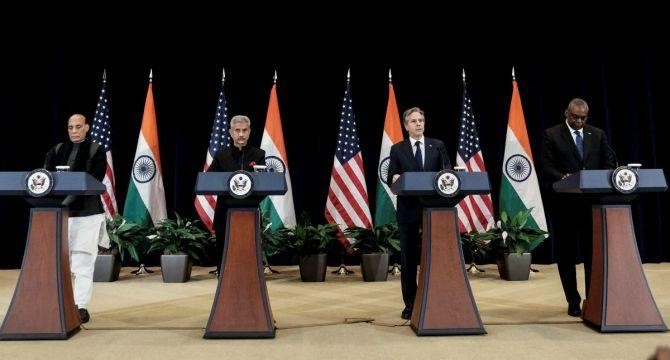Akriti Khajuria
17th May 2022

On 11 April, the Foreign and Defence Ministers of India and the United States convened for the 4th Annual India-US ‘2+2’ dialogue in Washington, D.C. The 2+2 dialogue was started in 2018 and other than the US; India has such dialogues with Australia, Japan and Russia. This dialogue is the highest-level institutional mechanism in place for discussion on matters of strategy and security. This meeting came amidst tempestuous circumstances in Ukraine. While the US has publicly condemned the actions of Russia and its invasion in Ukraine on multiple occasions, India has abstained from voting against Russia at the UN or publicly asserting Russia as an aggressor which in itself explains the significance of this dialogue. This meeting was heralded by the virtual meet between Prime Minister Modi and President Biden.
During this dialogue, both the sides reaffirmed their commitment on a plethora of issues vis-a-vis – “free, open and inclusive Indo-Pacific”; an inclusive architecture which abides by ‘the rule of law, the freedom of navigation and overflight, peaceful resolution of disputes, and ASEAN centrality’; reliable, and diverse supply chains for Critical and Emerging Technologies (CET) for regional and global innovation; and pledged to expand bilateral space cooperation wherein they signed a Space Situational Awareness Arrangement and launched Inaugural Defence Artificial Intelligence Dialogue.
This dialogue is significant as it provided opportunity to both the countries to put forth their differing perspectives on the Ukraine crisis from their respective standpoints. In the month of March, President Biden called India’s stand on the Ukraine crisis as “somewhat shaky” and additionally Biden’s top economic adviser, Brian Deese warned India of “significant and long-term consequences” on India’s increased “strategic alignment with Moscow”.
It was only during ‘2+2’ dialogue that both the nations exhibited keenness to acknowledge and comprehend the reason behind diverging viewpoints on the prevalent crisis. This dialogue pronounced a palpable shift from prior statements of the US as Mr. Blinken in the Joint press interaction stated, “India has to make its own decisions about how it approaches this challenge”. Furthermore, he also asserted that “India’s relationship with Russia has developed over decades at a time when the United States was not able to be a partner to India”. On that account ‘2+2’ dialogue aptly shed light on US’ apprehension of India’s stand on the crisis and its decision to willingly choose India as a ‘partner of choice’. In the joint statement both the sides also affirmed their commitment to collaborate in fields of commerce, energy, technology, and security.
While both India and the US have been trying to come on the same page despite their juxtaposing stances in these turbulent times, one of the major areas of concern is whether the US would provide India with cutting edge technology to produce military equipment in India as this would be the only way to reduce India’s dependence on Russia in matters of defence. Whilst US acknowledged India’s increased focus on enhancing its domestic capabilities in the field of defence, both the sides agreed to work on “co-production, co-development, cooperative testing of advanced systems, investment promotion, and the development of maintenance repair and overhaul facilities in India”.
As significant as this dialogue is, it also presents certain thoughts on India’s position and the present global scenario. First, generally people around the world weigh the significance of the US from India’s perspective, but this meeting brings into limelight a different standpoint. While the US is imperative for India, India is equally indispensable for the US to advance its interests in the Indo-Pacific in order to counter China. So, it is paramount to stop viewing and comprehending everything from the traditional standpoint which views the US as a superpower and India as a developing nation which still has a long way to go.
Second, this also proves that in the international scenario, the convergence of interests generally outweighs the divergences as the world as it stands today is interdependent and multi-faceted and no nation can hope for having a vantage in all situations. Third, the Ukraine crisis has placed India in a position where India can actually claim to be a part of a multi-polar world wherein all the actors are capable and continuously striving to promote their own national interests. India’s view on the crisis has turned out to be a stance in itself- a stance wherein India is committed to stay non-aligned and unbiased in the conflicts of other major powers while simultaneously taking decisions which are instrumental in promoting India’s own national interests such as buying Russian oil despite being rebuked by the West.
So, yes, India has practised diplomacy in such a way that it strengthens multipolarity and simultaneously strengthens India’s position in the multipolar world. Despite India’s disagreement with the US on the Ukraine crisis, both US and India came together to advance their relations on converging interests in various fields such as clean energy, military cooperation, people to people ties, technology and their perseverance to ensure an “open and inclusive Indo-Pacific.”
Lastly, what remains to be seen is how the US influences India to do its bidding. One of the remarkable strategies could be reducing India’s dependence on Russia especially in the defence sector by providing cutting edge technology to India. The question of the hour is how far would the US go to maintain its sway and dominion in the international sphere.
*The Author is a PhD Scholar the Amity Institute of International Studies (AIIS), Amity University (Noida)
Disclaimer: The Views in the Article are of the Author
![]()

